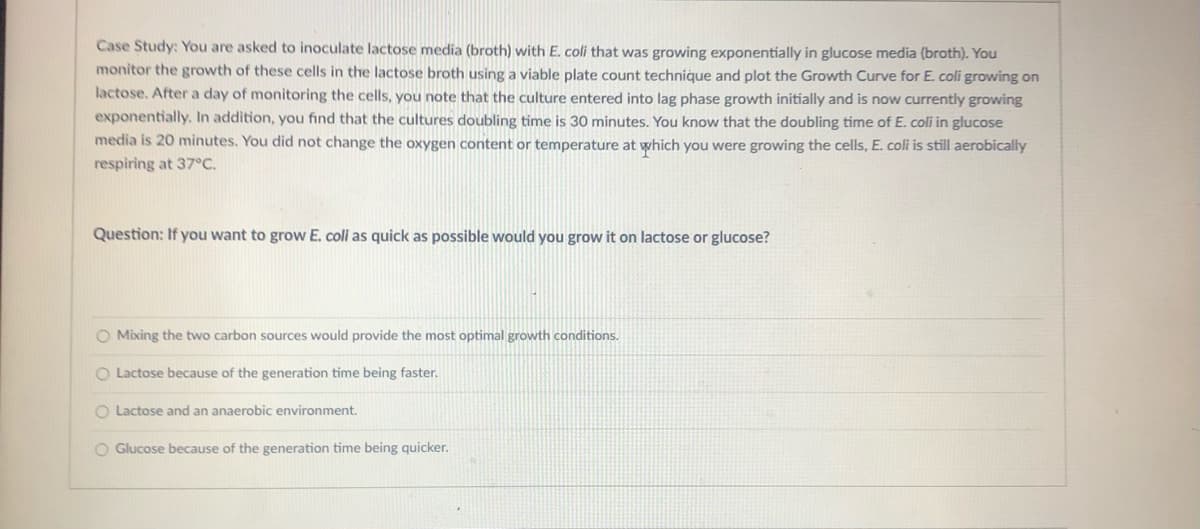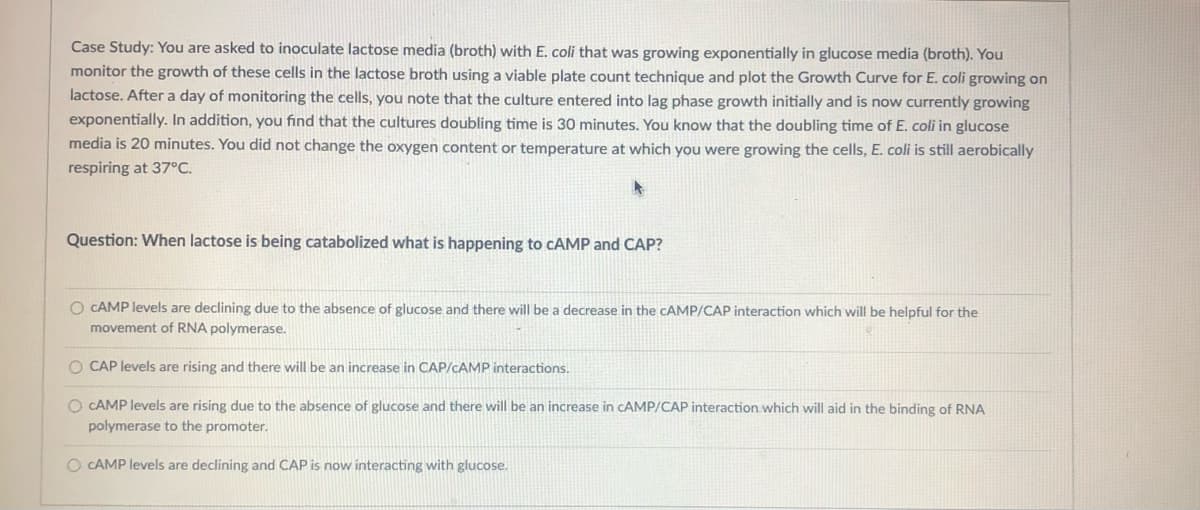Case Study: You are asked to inoculate lactose media (broth) with E. coli that was growing exponentially in glucose media (broth). You monitor the growth of these cells in the lactose broth using a viable plate count technique and plot the Growth Curve for E. coli growing on lactose. After a day of monitoring the cells, you note that the culture entered into lag phase growth initially and is now currently growing exponentially. In addition, you find that the cultures doubling time is 30 minutes. You know that the doubling time of E. coli in glucose media is 20 minutes. You did not change the oxygen content or temperature at which you were growing the cells, E. coli is still aerobically respiring at 37°c. Question: If you want to grow E. coli as quick as possible would you grow it on lactose or glucose? O Mixing the two carbon sources would provide the most optimal growth conditions. O Lactose because of the generation time being faster. O Lactose and an anaerobic environment. O Glucose because of the generation time being quicker.
Case Study: You are asked to inoculate lactose media (broth) with E. coli that was growing exponentially in glucose media (broth). You monitor the growth of these cells in the lactose broth using a viable plate count technique and plot the Growth Curve for E. coli growing on lactose. After a day of monitoring the cells, you note that the culture entered into lag phase growth initially and is now currently growing exponentially. In addition, you find that the cultures doubling time is 30 minutes. You know that the doubling time of E. coli in glucose media is 20 minutes. You did not change the oxygen content or temperature at which you were growing the cells, E. coli is still aerobically respiring at 37°c. Question: If you want to grow E. coli as quick as possible would you grow it on lactose or glucose? O Mixing the two carbon sources would provide the most optimal growth conditions. O Lactose because of the generation time being faster. O Lactose and an anaerobic environment. O Glucose because of the generation time being quicker.
Biomedical Instrumentation Systems
1st Edition
ISBN:9781133478294
Author:Chatterjee
Publisher:Chatterjee
Chapter19: Biomedical Laboratory Instrumentation
Section: Chapter Questions
Problem 2RT
Related questions
Question

Transcribed Image Text:Case Study: You are asked to inoculate lactose media (broth) with E. coli that was growing exponentially in glucose media (broth). You
monitor the growth of these cells in the lactose broth using a viable plate count technique and plot the Growth Curve for E. coli growing on
lactose. After a day of monitoring the cells, you note that the culture entered into lag phase growth initially and is now currently growing
exponentially. In addition, you find that the cultures doubling time is 30 minutes. You know that the doubling time of E. coli in glucose
media is 20 minutes. You did not change the oxygen content or temperature at which you were growing the cells, E. coli is still aerobically
respiring at 37°C.
Question: If you want to grow E. coli as quick as possible would you grow it on lactose or glucose?
O Mixing the two carbon sources would provide the most optimal growth conditions.
O Lactose because of the generation time being faster.
O Lactose and an anaerobic environment.
O Glucose because of the generation time being quicker.

Transcribed Image Text:Case Study: You are asked to inoculate lactose media (broth) with E. coli that was growing exponentially in glucose media (broth). You
monitor the growth of these cells in the lactose broth using a viable plate count technique and plot the Growth Curve for E. coli growing on
lactose. After a day of monitoring the cells, you note that the culture entered into lag phase growth initially and is now currently growing
exponentially. In addition, you find that the cultures doubling time is 30 minutes. You know that the doubling time of E. coli in glucose
media is 20 minutes. You did not change the oxygen content or temperature at which you were growing the cells, E. coli is still aerobically
respiring at 37°C.
Question: When lactose is being catabolized what is happening to CAMP and CAP?
O CAMP levels are declining due to the absence of glucose and there will be a decrease in the CAMP/CAP interaction which will be helpful for the
movement of RNA polymerase.
O CAP levels are rising and there will be an increase in CAP/CAMP interactions.
O CAMP levels are rising due to the absence of glucose and there will be an increase in CAMP/CAP interaction which will aid in the binding of RNA
polymerase to the promoter.
O CAMP levels are declining and CAP is now interacting with glucose.
Expert Solution
This question has been solved!
Explore an expertly crafted, step-by-step solution for a thorough understanding of key concepts.
This is a popular solution!
Trending now
This is a popular solution!
Step by step
Solved in 2 steps

Knowledge Booster
Learn more about
Need a deep-dive on the concept behind this application? Look no further. Learn more about this topic, biology and related others by exploring similar questions and additional content below.Recommended textbooks for you



